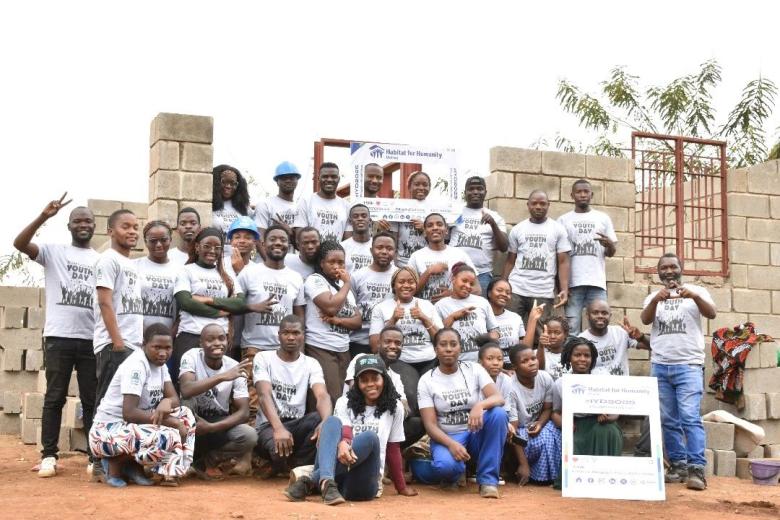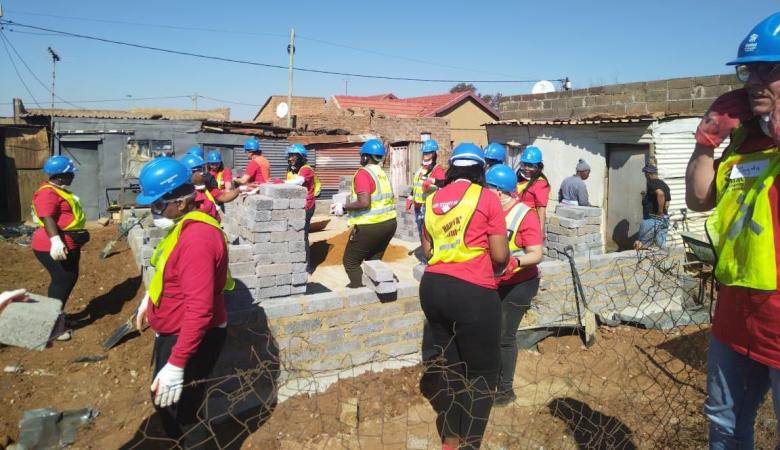Everything you need to know about volunteering with Habitat for Humanity
At Habitat for Humanity, volunteering takes on many shapes. Not every volunteer may swing a hammer, but every volunteer helps move us closer to a world where everyone has a decent place to live.
In just the first half of 2025, more than 3,300 people volunteered with Habitat for Humanity across Europe and the Middle East. Some helped build homes in Romania, Kenya, and Malawi. Others organized charity dinners in Poland, sorted donated goods in Irish ReStores, ran upcycling workshops in Great Britain, or supported communications and events in Jordan and Egypt. No two roles are alike. There is something for everyone who is willing to help.
At Habitat for Humanity, volunteering takes on many shapes. Not every volunteer may swing a hammer, but every volunteer helps move us closer to a world where everyone has a decent place to live.
In just the first half of 2025, more than 3,300 people volunteered with Habitat for Humanity across Europe and the Middle East. Some helped build homes in Romania, Kenya, and Malawi. Others organized charity dinners in Poland, sorted donated goods in Irish ReStores, ran upcycling workshops in Great Britain, or supported communications and events in Jordan and Egypt. No two roles are alike. There is something for everyone who is willing to help.
Meet Veronika
“Each of our programs is unique and provides unique volunteering experiences,” says Veronika Cruz Bodova, Senior Volunteer Engagement Specialist, who has worked in the field since 2014. “The goal is to connect a wide range of people to the communities we serve through meaningful work that has a lasting impact.”


For years, Veronika has seen the power of Habitat’s approach firsthand, but her experience with volunteering started before joining Habitat.
“I started volunteering when I was 14, as an assistant in a school for visually impaired and blind children in Bratislava, Slovakia. Later, I volunteered with youth with disabilities in Prague, Spain, and Turkey. It taught me how much you can learn by stepping out of your comfort zone. It’s how I met people from different cultures and backgrounds—many of whom I’m still friends with today.”
Global Village
Habitat for Humanity’s best-known program is Global Village. This volunteer opportunity allows individuals and groups to travel to a new country and work side by side with local communities on construction and renovation projects.
Working alongside the people you’re helping creates mutual respect and deepens understanding. For those who do want to go abroad, Global Village offers a unique way to support communities around the world, without slipping into the trap of voluntourism, which often refers to short-term volunteer experiences that prioritize the traveler’s experience over meaningful, lasting impact.
“It is important to bear in mind that voluntourism is not what we do, and it’s not what we should ever do,” Veronika says. “Our volunteers do real work. If you’ve ever done a week-long build, you know: the fatigue and pain usually arrive by day three.”
“If you’re looking to wash an elephant or squeeze in a visit to an orphanage between tourist activities, Habitat probably isn’t the right fit,” Veronika says. But if you’re ready to serve, to learn, and to contribute meaningfully? There’s a place for you here.
Habitat’s Global Village is an immersive experience rooted in genuine partnership, but there are dozens of other ways to get involved without ever getting on a plane.
Retail, events, and more
Habitat for Humanity ReStores in Ireland and the UK are second-hand thrift stores that sell donated furniture, household goods, and building materials at affordable prices. All proceeds go directly to further Habitat work.
At the stores, volunteers sort through donations, assist customers, and organize displays. This is a great option for people who enjoy retail, sustainability, and customer service. The stores are places that become little community hubs with people coming in and out to shop and donate. Volunteers invest their time while building real relationships because they are in direct contact with the people who are benefiting from the donations.
Something for everyone
Volunteers help with construction, yes, but also with event planning, marketing, and fundraising. Some support office operations or IT. Others contribute to photography, design, and storytelling. Some volunteers give a few days of their time. Some give years.
And some contribute through advocacy, using their voice to raise awareness, push for better housing policies, or influence decision-makers. Whether writing letters, organizing campaigns, or joining local housing coalitions, advocacy volunteers help create long-term, systemic change.
“Not everyone is on a build site. But every one of them is vital to our mission, to make sure everyone has a decent place to live,” says Veronika.
Partnerships with schools
For Veronika, as Habitat’s program specialist, one of the most exciting developments in recent years has been the way Habitat for Humanity partners with schools and universities!
“I love that we get to work with educational institutions that actually implement volunteering into their semester or curriculum. It becomes part of a social learning experience, not just an activity,” says Veronika, who herself started out volunteering in schools many years ago.
Habitat for Humanity engages youth in ways that are meaningful and age-appropriate. Students not only learn practical skills but also reflect on global housing challenges and how they can address them.
University partnerships have even expanded to include research, architecture collaborations, and long-term internships. These opportunities let students contribute through what they’re studying, whether it’s engineering, communications, or social work.
Corporate volunteering
More and more companies are choosing to volunteer with Habitat for Humanity as a way to give back while strengthening their teams.
Corporate volunteering is an opportunity for employees to step away from the office and engage in volunteer work, whether that’s building homes, helping in ReStores, or contributing professional skills like finance, marketing, or HR support.
These partnerships help Habitat fund its projects and allow businesses to live out their corporate social responsibility in tangible ways. At the same time, employees gain valuable team-building experiences and often return to work energized and more connected to their communities and teams.
“We are proud to support Habitat for Humanity through this long-term partnership, which is grounded in shared values and a common belief that everyone deserves a healthy, safe and decent place to live. It is inspiring to see colleagues from across the VKR Group coming together in a Donate Your Steps walking challenge for a cause that brings new life to old buildings - and new hope to families,” says Robert Purol, Board Member, Employee Foundation of the VKR Goup & General Manager, NB Polska Sp. z o.o.


Volunteering the right way
Veronika has seen firsthand what happens when expectations go wrong: “That so-called ‘savior complex’, especially when volunteers from the Global North work in Global South communities, can do more harm than good. It can lead to burnout, disappointment, and even damaged relationships. Our communities are not projects. They are partners.”
It’s important to remember that when we volunteer, we go to help, not to save. “A meaningful volunteer experience can open doors, personally, professionally, and emotionally. It can help you discover new skills, new friendships, and even a new sense of purpose. You grow. And you have fun while doing it.”
“Volunteering builds more than houses,” Veronika says. “It builds understanding. It builds community. And it gives all of us a chance to be part of something that lasts.”
“The most important thing for me is that our volunteers do impactful work, on and off the build site. What they do matters. And what they learn often stays with them for life. I would recommend volunteering to anyone who’s willing to broaden their horizons and experience something new. You have to come in with the right mindset. You’re not a hero or a savior, you’re a partner, working alongside others to improve housing conditions.”
Whether you’re a student, retired, or someone just looking to get involved, Habitat for Humanity offers volunteer opportunities that match your time, talents, and interests.
You don’t have to be a construction expert or commit full-time. All you need is a willingness to show up, learn, and contribute.
Ready to build something that lasts?
Discover volunteer opportunities near you or abroad at: www.habitat.org/volunteer.

Everything you need to know about volunteering with Habitat for Humanity





























